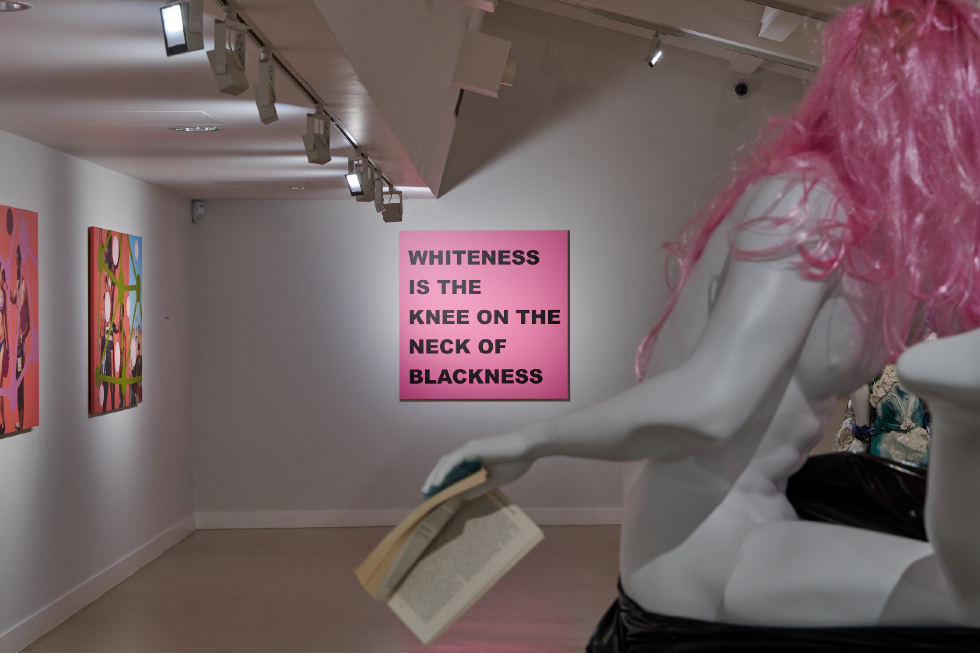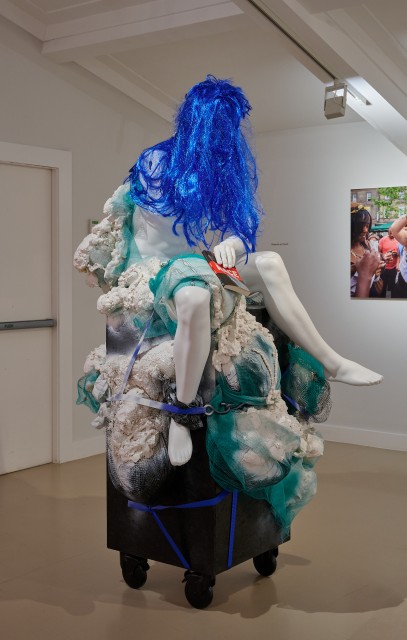Michael Forbes: Blk this & Blk that… A State of Urgency – Reviewed

From racial politics to migration, history, and religion, Blk this & Blk that… A State of Urgency addresses a plethora of pertinent themes, finds Mike Pinnington…
“May you live in interesting times” goes the old expression; meant as a curse, it is a sly observation that life is better, more tranquil, the less interesting it gets. I think it’s fair to say that, sadly, we currently live in very interesting times indeed. Politicians having failed us (seemingly actively working against us at times), it is left to others to attempt to translate, contextualise, and navigate the choppy waters in which we find ourselves.
All of which brings me to Blk this & Blk that… A State of Urgency, the timely exhibition of Nottingham-born artist Michael Forbes’ work. In it, the artist addresses a plethora of pertinent themes. From racial politics to migration, history, and religion; Forbes, referring to what he calls the dichotomy of blackness and whiteness, is interrogating topics that affect us all in one way or another.
Across sculpture, installation, photography, and digital media, questions are posed and tease out where we are as a society, one in which white supremacy still blunders unabated. Sometimes, unless pointed out, it can do so in subtle ways. With background noise. In Shop… Selling the ontology of Whiteness (2016–2022) Forbes exposes how this can manifest in the everyday. His lightbox works feature mannequins; predominately white, a much smaller number are brown; a few have black person’s facial features. These are often produced in white or blue, ‘neutralised.’ Erasure via window display.

More immediately obvious are the proclamations of his #BLM works. Some of them featuring slogans found at Black Lives Matter protests in Nottingham, they speak to the urgency at hand. “WHEN THE COLOUR OF YOUR SKIN IS SEEN AS A WEAPON YOU WILL NEVER BE SEEN AS UNARMED” screams one. “STOP FUCKING KILLING BLACK PEOPLE” demands another. Removed from the context of a bustling protest to the white walls of a gallery, if anything, their impact is enhanced. In isolation, and with time and space to contemplate, the mind lingers longer and more deeply on the implications for black bodies in society. A powerful use of text and colour, these placards as artworks live long in the memory.
From the analogue to the digital, video work An Eldorado of 512.6 million (2019 – 2020), finds black bodies in cruciform poses, tossed and engulfed amid a sea of gold. The film speaks of those seeking the promise of better lives away from poverty, conflict and violence; from Africa to these shores. Made in the years following then Prime Minister Theresa May’s assertion that Britain would prove a “really hostile environment” for so-called illegal immigrants, it embodies a poignant and tragic truth that their reception on arrival can be, in many cases, the least of peoples worries.

In Untitled (white man’s burden), we have yet more mannequins. Arranged on plinths and adorned with garishly coloured wigs, partially wrapped in black PVC, they might represent statues of dead white men to be overthrown, toppled. And, although their positions seem precarious and to be lampooned, we nevertheless are required to look up at them – a fact reaffirming racial, as well as social, hierarchies. In their hands they hold books on racial politics, a hint perhaps that we are at a tipping point; that if people were willing to be conscious, to be open, to learn, things could change for the better. Knowledge is power; not necessarily wielded only for the good of the few.
This point is reiterated in an accompanying exhibition reading list. On it we find recently published writings from the likes of Kehinde Andrews, Reni Eddo-Lodge and Nikesh Shukla. It also contains what we might think of today as foundational texts. “To be a poor man is hard, but to be a poor race in a land of dollars is the very bottom of hardships” wrote W. E. B. DuBois in 1903’s The Souls of Black Folk: Essays and Sketches. It’s not so very different from the language or dilemma of today. That ALL LIVES CAN’T MATTER UNTIL BLACK LIVES MATTER.
Mike Pinnington
Images: courtesy Nick Dunmar





